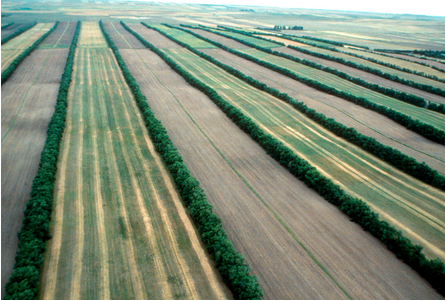Strategic deployment of riparian buffers and windbreaks in Europe can co-deliver biomass and environmental benefits
A recent scientific article in Communications Earth & Environment shows that a strategic introduction of perennial crops, such as grasses and fast-growing trees in the form of riparian buffers and windbreaks, can co-deliver biomass and environmental benefits.
Within the scope of the new Common Agricultural Policy of the European Union, new incentives are developed for farmers to deploy practices that are beneficial for climate, water, soil, air, and biodiversity. Such practices include establishment of multifunctional biomass production systems, designed to reduce environmental impacts while providing biomass for food, feed, bioenergy, and other biobased products. The study presented in the paper modelled three scenarios of large-scale deployment for two such systems, riparian buffers and windbreaks, across over 81,000 landscapes in Europe, and quantify the corresponding areas, biomass output, and environmental benefits. The results show that these systems can effectively reduce nitrogen emissions to water and soil loss by wind erosion, while simultaneously providing substantial environmental co-benefits, having limited negative effects on current agricultural production. This kind of beneficial land-use change using strategic perennialization is important for meeting environmental objectives while advancing towards a sustainable bioeconomy.
The work was financed by the Swedish Energy Agency and f3 Swedish Knowledge Centre for Renewable Transportation Fuels. Additional support has been provided by IEA Bioenergy Task 43 (Biomass Supply) and Task 45 (Climate and Sustainability Effects of Bioenergy).
The full article is available in open access at: https://www.nature.com/articles/s43247-021-00247-y
Full citation: Englund, O., Börjesson, P., Mola-Yudego, B., Berndes, G., Dimitriou, I., Cederberg, C., Scarlat, N., (2021). Strategic deployment of riparian buffers and windbreaks in Europe can co-deliver biomass and environmental benefits. Communications Earth & Environment,2:176 (2021) https://doi.org/10.1038/s43247-021-00247-y
Quotes from the authors:
- “We have previously shown that there is a substantial potential for using so called multifunctional biomass production systems in Europe. By implementing these on a large scale, we can mitigate many of the impacts we have caused by large-scale agriculture in EU and maintain or increase the overall biomass productivity at the landscape scale. What we have done this time, is to exemplify how this can be done and quantify the effects.”
- “Riparian buffers are primarily relevant in north-western and central Europe, while windbreaks are generally relevant in coastal areas and other areas subject to recurring strong winds. Denmark is one example of where the potential for this kind of strategic perennialization is massive. Implementing riparian buffers on a large scale in Europe can result in that up to a third of all nitrogen emissions to water is avoided, while 33 million tonnes of carbon is stored in soils, and 3 million tonnes of agricultural soil, that would otherwise be eroded, is preserved. It is also interesting that both riparian buffers and windbreaks can be effective for flood mitigation, which is currently high on the political agenda in Europe.”
- “What is especially interesting about these options is that we can harvest both buffers and windbreaks for biomass instead of setting aside land for the purpose of impact mitigation. This means a higher land use efficiency, which is necessary to uphold or increase biomass production for the bioeconomy. This clearly shows that we can resolve many of our self-inflicted environmental problems without necessarily sacrificing agricultural productivity.”
- “Multifunctional biomass production systems will not be established unless farmers receive proper compensation for the societal benefits they provide. It is also important that local conditions are taken into account, as the design and effects of these systems will differ from location to location. It is therefore necessary to raise the knowledge of opportunities with multifunctional biomass production systems among all EU member states, before country specific Eco-scheme options are designed and introduced in the new CAP.”
Figure: Areal view of riparian buffers (left) and windbreaks (right) in an agricultural landscape.
Credit: National Agroforestry Center. https://creativecommons.org/licenses/by/2.0/legalcode




